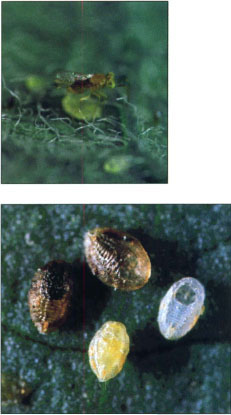All Issues
Silverleaf whitefly extends range
Publication Information
California Agriculture 52(2):6-7.
Published March 01, 1998
PDF | Citation | Permissions
Full text
The silverleaf whitefly has extended its range from the Imperial Valley into the San Joaquin Valley, where it has become a pest of cotton in areas where there is a high concentration of both cotton and citrus. “We have found silverleaf whitefly as far north as Merced County,” says UC entomologist Charles Summers.
Scientists are testing the effectiveness of parasitoids for silverleaf whitefly control. Top, an Encarsia pergandiella lays its egg in a silverleaf whitefly nymph. Above, whitefly nymphs parasitized by E. pergandiella and Encarsia luteola.
The agricultural commissioner's office in Imperial Valley reported a $111 million crop loss in 1991–1992. Now that growers have adjusted to the pest, that kind of crop loss should not occur again, but the big cost is in pesticides. The melon crop probably uses the most pesticides. Melon growers apply pesticides two to five times per season. In 1996, Imperial County growers spent roughly $12 million to protect 49,442 acres of melons from silverleaf whiteflies.
UC scientists and state Department of Food and Agriculture (CDFA) scientists are cooperating in battling the expensive pest. UC's Summers is tracking the movements of silverleaf whitefly, while CDFA entomologist Charles Pickett is researching the prospects for biological control of the pest.
Summers, who is based at the UC Kearney Agricultural Center in Parlier, is investigating the role of citrus and weeds in the spread of silverleaf whitefly. In 3 years, from 1993–1996, he witnessed whiteflies escalate from zero to 1,000 eggs per orange leaf.
“These infestations were initiated in 1994 from eggs laid on the fall flush of citrus leaves by adults migrating from cotton following defoliation,” Summers explains. “Silverleaf whitefly survived the winters of 1994–95 and 1995–96 in all life stages on citrus.”
During the late summer and early fall of 1996, there was an unprecedented migration of silverleaf whitefly adults into citrus in eastern Tulare County. In a survey conducted in September 1996, Summers found populations of silverleaf whitefly nymphs were high enough to leave large quantities of honeydew on the fruit.
“Silverleaf whitefly has become adapted to citrus over the past 3 to 4 years and is currently a year-round resident,” he says.
CDFA entomologist Charles Pickett is investigating the role that parasitoids may play in controlling silverleaf whitefly. The USDA collected and screened parasitoids from different parts of the world. Pickett has released large numbers of these exotic parasitoids into citrus and other crops where silverleaf whitefly overwinters in the Imperial and San Joaquin valleys. He hopes to increase the number of the whitefly's natural enemies. “We have one native species of Eretmocerus eremicus and two species of Encarsia that didn't do much,” he explains. “We're trying to increase their diversity. The different parasites may perform better in some crops than others because every type of plant represents a different habitat.
“We have three or four that look promising; they've persisted over a year, maybe 2 years in some locations,” Pickett says. The new species of Eretmocerus collected in Spain, Pakistan and the United Arab Emirates are in the process of being described so they don't have official names.
“Our long-term goal is to reduce the whitefly in noncrop situations — urban areas and along margins and perimeters of fields. If we can do that, it may reduce regional populations and the frequency of pesticide applications may drop.”
Applying parasitoids instead of pesticides to fields may be another alternative for growers. Pickett has also experimented with biocontrol by augmenting with parasitoids mass-reared at CDFA's biological control greenhouse facility in Sacramento and with the USDA-APHIS in Brawley. Last year and this the augmentative trials are being done on a large scale in the Imperial Valley. He is placing the parasites in commercial organic fields and comparing their control with conventional fields that use the pesticide imidacloprid.
“We are using an Eretmocerus collected from the United Arab Emirates for the augmentative studies. About 3 years of data show that you can get comparable control, and the cost is comparable in spring melons,” he says.
Pickett is also using transplants as a vehicle for getting the parasites into the field. Transplants are inoculated with whiteflies, then parasites just prior to planting in the field so 95% or more of the whiteflies will be parasitized. “We think this may be a more efficient means of releasing the parasites, reducing the overall cost,” he says.
—Editor





